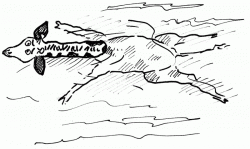Loch neck monster? Computer says giraffes can float
Q. Will a giraffe float? –C. Livingston
A. Although a few rare photographs show giraffes wading into deep rivers when they have to, definite observations have yet to be reported, says Darren Naish in Scientific American magazine. Pushing one into a deep pool to see what happens obviously raises ethical issues, so Naish approached Canadian paleontologist Donald Henderson to help create a computer model "digital giraffe" to try to settle the question. Center of mass had to be factored in, along with buoyancy, limb drag in water, and the animal's unusually shaped lungs.
Putting it all together and crunching the numbers, Naish and Henderson concluded that giraffes probably can float but would be clumsy and unstable in the water, with their heavy forelimbs pulling them down and forcing their long neck into a near horizontal position. Due to their high density, giraffes would sit low in the water.
"This might seem like a frivolous exercise," says Naish, "but our study showed that scientists can rely on complex computer simulations to help examine fascinating questions in biomechanics."
Q. What Thomas Edison innovation (not an invention) do English speakers use every day? –L. Tomlin
A. The word "hello" as a telephone greeting is the surprising answer here, though the first written use of "hello" goes back to the early 1800s, say John Lloyd and John Mitchinson in The Book of General Ignorance.
In an 1877 letter, Edison suggested the best way of starting a telephone conversation was with "hello," because it "can be heard ten to twenty feet away." He discovered this while testing inventor Alexander Graham Bell's prototype phone; Bell himself preferred the rather nautical "Ahoy, hoy!"
"Halloo," a favorite of Edison's, was used at the time to call hounds and ferrymen. He used the word when he discovered how to record sound and would shout it into the machine. Edison also used to shout "hello!" into telephone receivers at Menlo Park Labs as he worked on improvements to Bell's design. His habit spread to coworkers and to telephone exchange operators until it supplanted the older "Are you there?" "Who are you?" or "Are you ready to talk?" Soon the operators became known as "hello girls."
By the way, the earliest recorded use of delegate badges saying "Hello, my name is..." was at the first telephone operators' convention in Niagara Falls in 1880.
Q. In 2011, we experience four unusual dates, 1/1/11, 1/11/11, 11/1/11, 11/11/11. Now go figure this out. Take the last two digits of the year you were born plus the age you will be this year and it will equal 111. It's fun, but what is being overlooked? –A. Einstein
A. It ignores those supercentenarians born in 1899 or before– and there are an estimated 300-450 alive today worldwide. So people born in 1899 would take 99, add it to their age of 112 and get 211, not the 111 predicted.
Q. What does "a slow dance across the Earth's surface at about the same speed as fingernails grow"? –C. Columbus
A. The ground beneath our feet is not completely solid, and the continents are always on the move, says Bill McGuire in 30-Second Theories. Periodically in our planet's history, the "dance" brought them clustering together to form a giant supercontinent– Rodina around 1.3 billion years ago and Pangea 250 million years– before they once again went their separate ways. So those apparently steadfast continents are forever "hitching free rides on the churning convection currents in Earth's oatmeal-like mantle beneath.
The idea of the mobility of continents actually goes back to 1596 when a Belgian cartographer noted the congruity of the African and South American coastlines, but the idea of constant movement didn't come about until some 300 years later. By the early 1960s, the plate tectonics theory had become the generally accepted mechanism to explain this constant motion.
~
Send Strange questions to brothers Bill and Rich at
